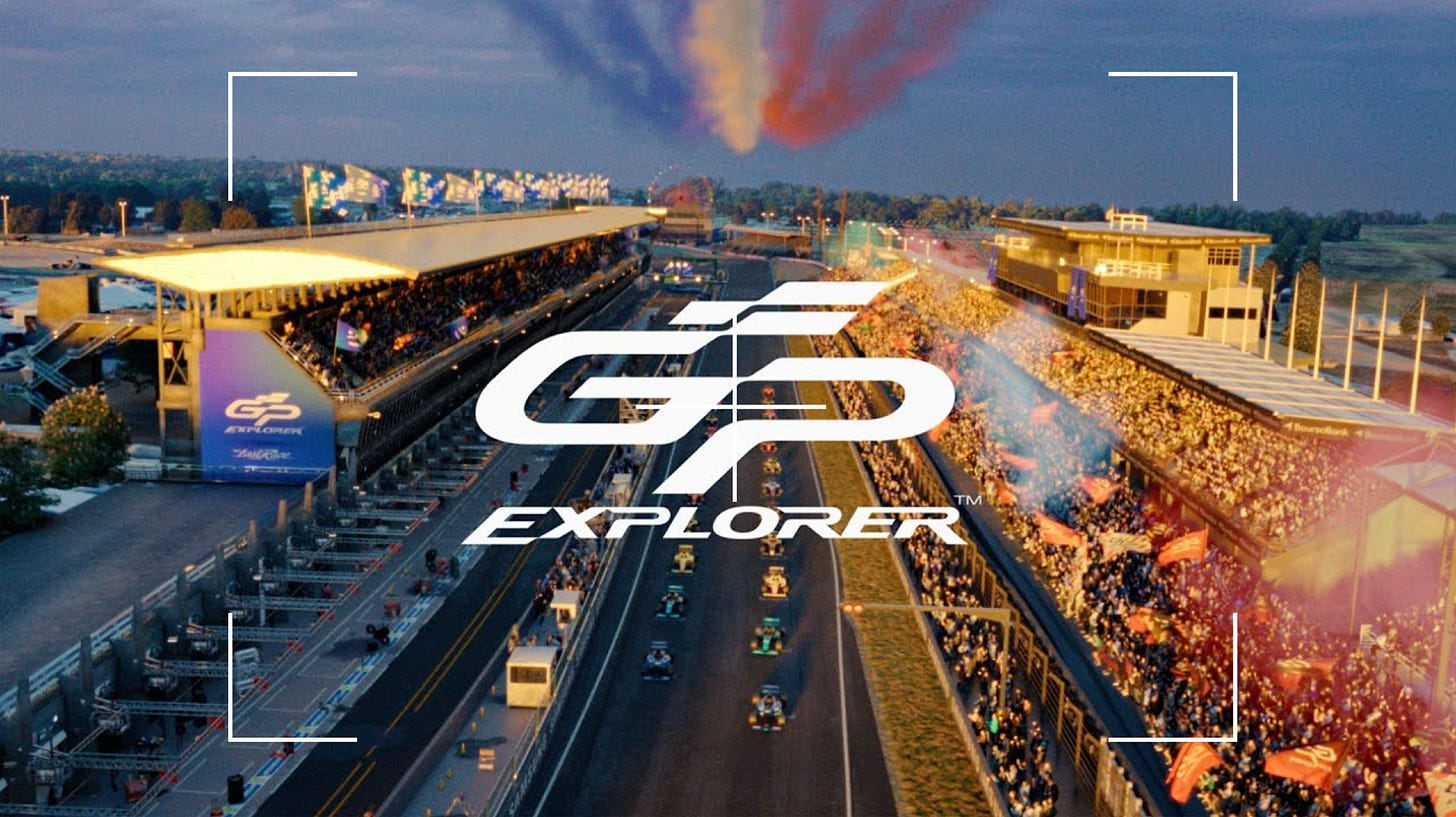GP Explorer: the race that redefined motorsport for a new generation
Twitch, culture and F1’s next generation collided this past weekend.
Thank you for being here. You are receiving this email because you subscribed to Idée Fixe, the newsletter for curious minds. I’m Toni Cowan-Brown, a tech and F1 commentator. I’m a former tech executive who has spent the past five years on the floor of way too many F1, FE, and WEC team garages, learning about the business, politics, and technology of motorsports.
⏳ Reading time: 8minutes
This weekend, something remarkable is coming to an end. It’s one of those moments in life when I wish I could turn back time and ensure I was present for this one event. Alas, like millions of others, I’ll be tuning in via Twitch - turns out, watching this event online was actually a lot of fun.
Welcome to GP Explorer 3 - The Last Race, the finale of a cultural experiment that began as a streaming stunt and became one of the most compelling case studies in how sports are evolving for the next generation of fans. It’s coming to an end, not with a whimper of declining interest or a quiet sunset into irrelevance, but with 200,000 tickets sold, international expansion, and France Télévisions picking up broadcast rights. GP Explorer is calling it quits at the peak of its powers, and this may be the most disruptive thing about it.
Saturday morning at Le Mans, rain lashed across the Bugatti Circuit. The start of practice was delayed, drivers paced in their garages, and chat windows on Twitch exploded with anticipation. These weren’t your usual professional racers waiting out the storm - they were YouTubers, streamers, and rappers, and they were about to do something many motorsports series have tried and failed to do. Just don’t call it a new motorsport series because that’s not what this is.
The origin story nobody saw coming
GP Explorer started, fittingly, as a dare. During a charity stream in 2021, French YouTuber Squeezie (real name Lucas Hauchard) promised to organise a real-life race if donations hit a certain target. They did - spectacularly - and that challenge materialised into something motorsport executives are most likely still trying to understand: a Formula 4 race that pulled over one million concurrent Twitch viewers (making it France’s most-watched livestream ever) and drew 40,000 people to Le Mans’ Circuit Bugatti. And this was just the beginning.
The sequel, in 2023, filled 60,000 seats trackside (those tickets sold out in 30 minutes), rivalling national motorsport events in attendance. The event’s total online reach surpassed 20 million unique viewers across platforms.
This year’s “The Last Race”, the organisers went even further. They expanded the event to three days, added concerts and fan zones, created an original soundtrack, added international creators from beyond France on the grid, multiple streams in different languages, introduced a sprint race format, and sold out in just two minutes (200,000 tickets).
For the first time, a broadcast on France 2 and France 4 (according to the latest numbers published on Sunday evening, 1.2 million people tuned in on France 2). And to top it off, this year’s race had 1.4 million concurrent Twitch viewers. As we thought they might, they obliterated their previous numbers. In three years, GP Explorer leapt from internet experiment to mainstream television. That trajectory alone tells a story about where motorsport, and fandom itself, is heading. The numbers don’t lie.
To put that in perspective, these numbers aren’t just impressive for a creator-led event. They are competitive with actual professional motorsport viewership in key demographics. And it was organised by someone who makes YouTube videos about video games. The traditional motorsport playbook was unceremoniously tossed out the window. No multi-million dollar marketing campaigns. No celebrity ambassadors. Instead, internet personalities, actual F4 cars, and an audience that had never been asked to care about motorsport before, so they didn’t know they weren’t supposed to show up. And this is precisely why it worked.
Meanwhile, traditional motorsport series continue wringing their hands about “reaching younger audiences.” Brand partners took note: from Ubisoft to BMW France, via Netflix, Durex, and Lego… companies queued up to align with a property that reached Gen Z in a way traditional racing rarely does.
Why Traditional Sports Should Be Taking Notes
Motorsport has always been an elite ecosystem: expensive, exclusive, and, at times, intimidating. Drivers start karting before they can drive legally, and the financial barrier is sky-high. Audiences, meanwhile, are ageing - still a constant anxiety in Formula 1 (even though the average age has never been as low as it is today) and beyond. GP Explorer cracked that wall open.
And as Gabriel Aubry, Former professional driver and Partner at Touring, points out, there is an interesting parallel here between what four-time World Champion Max Verstappen is doing and the GP Explorer. One is redefining excellence on track, the other is redefining how people discover the sport.
“Two different worlds, two different models, yet both Max Verstappen and GP Explorer are breaking down the same barrier: accessibility. One does it from the pinnacle of racing, investing in sim drivers like Chris Lulham through Team Redline; the other from the digital frontier, where Squeezie turns entertainment into an entry point for a new generation of fans. Max Verstappen and Squeezie couldn’t be further apart - one a world champion, the other a master digital creator and entertainer. Yet both are lowering the barriers to one of the world’s most exclusive sports. Together, they’re proving that motorsport’s future isn’t about gatekeeping speed, but sharing it.”
Here’s where it gets interesting for the C-suite executives reading this: GP Explorer didn’t democratise motorsport by making it cheaper or more accessible to compete in. The drivers still trained for months, obtained racing licenses, and drove real Formula 4 cars on a legitimate circuit. The democratisation happened in the meaning of the sport itself.
Traditional motorsport has always asked audiences to care about legacy, technical precision, and athletic excellence. GP Explorer asked audiences to care about their favourite creators, trying something audacious. One approach relies on aspirational distance; the other on parasocial proximity. Guess which one resonates with Gen Z?
By placing creators, people who already have communities, storytelling instincts, and on-camera charisma, behind the wheel, it offered a new access point to racing. In addition, having some of your favourite Twitch streamers on-site, commentating and streaming the race was absolutely genius as the effect was the same. Fans who might never watch an F1 qualifying session tuned in for their favourite streamer, nervously learning to race. The appeal wasn’t pure speed or perfection; it was relatability and the very human chaos of it all.
It’s motorsport rewritten for the era of participatory media, where fans expect to interact, not just spectate.
The content-first model that’s rewriting engagement
What GP Explorer understood is something that traditional sports are still learning: content precedes fandom, not the other way around. These weren’t anonymous drivers in identical suits. They were creators whose audiences had watched them play Minecraft, react to memes, and navigate everyday chaos. The racing was the novelty; the personalities were the foundation. And I actually think this is a great takeaway for any athlete today that wants to succeed and buidl a lasting brand and career, and yet at the same time I am torn, because I firmly believe we are asking too much of our athletes today - having an online presence, connecting with fans, building a brand, creating merchandise… essentially building and runing a media empire whilst trying to be the best at their sport (an essay for another day).
Back to this weekend’s event, there were concerts featuring French rap artists like Vald and SCH. There were viewing parties and watch-alongs. The event was designed to be consumed and remixed across platforms simultaneously. This is the Netflix “Drive to Survive” playbook taken to its logical conclusion: if personality-driven narratives can revive interest in F1, why not start with the personalities and build the sport around them? Or, in doing so, are we destroying the essence of what it means to be - and become - one of the world’s best athletes? Either way, for anyone in attendance that I spoke with, the reviews were glowing, and the experience was one to remember.
“A huge success for the final edition - the sprint format worked brilliantly, and the crowd showed up in full force across both days. The races were packed with action and unexpected twists, from sunshine to rain, and even live concerts. The entire internet culture came to life in this last edition, setting audience records never before seen in France.”
Julien, Formula 1 Content Creator
And they took it a step further, since the inception of the idea, they also found ways to legitimise the event. Firstly, the French Motorsport Federation (FFSA) and ACO (organiser of the 24 Hours of Le Mans) legitimised it by overseeing licensing and safety. This wasn’t cosplay racing; it was fully regulated motorsport - just reframed through a creator lens.
Secondly, for the 2025 edition, the race was broadcast on national TV, marking a symbolic hand-off from digital to legacy media. The internet didn’t just infiltrate motorsport; it rebuilt it from the inside out.
The strategic brilliance of quitting while ahead
And now, after three years of explosive growth, it’s ending - certainly not because it failed, but because it succeeded beyond its creators’ bandwidth. Scaling an event that merges racing, festival logistics, and digital production is a Herculean effort.
“The Last Race” isn’t a marketing gimmick - Squeezie has confirmed this is genuinely the final edition. In an era where every successful format gets franchised, internationalised, and run into the ground, voluntarily stepping away seems almost radical.
But it’s also deeply strategic. By ending at peak interest, GP Explorer preserves its mythology. It doesn’t risk the inevitable decline that comes when novelty wears off or when scale compromises quality. Every future conversation about creator-led sports events will reference GP Explorer not as a cautionary tale, but as proof of concept.
The model is too potent to disappear and it’s certainly offered a blueprint for what the future motorsports fan may actually want. I sincerely hope the likes of WEC, FE and Formula 1 will be studying this closely. Squeezie also teased on Sunday (and previously) that the GP Explorer will lead to something else, something bigger: a league.
What this means for future sports entertainment
Simultaneously watching the Singapore F1 GP and “The Last Race” this weekend, I was surprised at how inevitable it all felt. Three years ago, this event and format didn’t exist. Five years ago, F1TV wasn’t quite yet the incredible product it is today. I was not tuning in while scrolling furiously on IG and TikTok to keep up with the online discourse, and I was certainly not live-streaming a race via a political commentator’s Twitch stream (Hasan Piker). It felt inevitable because of course, this is where sports entertainment is heading.
The lesson here isn’t “hire some YouTubers and hope for the best.” It’s about understanding that Gen Z’s relationship with sports isn’t broken - it’s just different. They don’t want less access to personalities; they want more. They don’t want higher production barriers; they want authentic experiences. They don’t want sports to be more serious; they want them to be more human.
GP Explorer proved you could take a legitimate, technically demanding motorsport, make it genuinely entertaining through personality and narrative, and build an audience that never knew they wanted this - until someone bothered to create it for them, and for that we are eternally grateful, Squeezie.
Traditional sports properties have spent years asking, “How do we get young people interested in our sport?” GP Explorer answered a different question entirely: “What if we just gave young people a reason to care?”
As the checkered flag waves on this experiment for the final time, the real race is just beginning. Every sports property watching 200,000 people show up for Formula 4 drivers (for a whole weekend), they’d never heard of three years ago, is now wondering: what are we doing wrong?
The answer, as usual, is probably simpler than they think. Sometimes you don’t need a bigger budget or a better marketing strategy. Sometimes you just need to build something that people actually want to watch. Even if, especially if, it means knowing when to walk away.
GP Explorer’s real legacy isn’t a trophy; it’s a blueprint. It showed that motorsport doesn’t have to choose between credibility and culture. A Twitch chat can sit alongside telemetry data. A community, not corporations, will fill grandstands. In the end, this wasn’t just a race. It was a reminder that the next wave of sports fandom will be defined not by who has the fastest car, but by who tells the most human story - live, messy, and one Twitch emote at a time.
🔗 A love letter to Formula 1 | The Road Rat
A love letter to Formula 1, presented by the world’s most beautiful car magazine. Including a foreword by Max Verstappen. Exclusive photo shoots with seven World Champions and pinnacle cars from the sport’s history, plus rarely seen historic images and contributors including Zak Brown, Mark Webber, Richard Mille and the Duke of Richmond, all paying tribute to 75 years of F1. Buy here.
🔗 How Rolex Paved the Way for Luxury’s Love Affair With Tennis | FOS
When Iga Świątek and Carlos Alcaraz hoisted their trophies on the clay courts of Roland-Garros last year, they had already ditched the terry-cloth sweatbands on their wrists for Rolex watches—the gold crown logo a ubiquitous presence in the professional tennis world. Read here.








